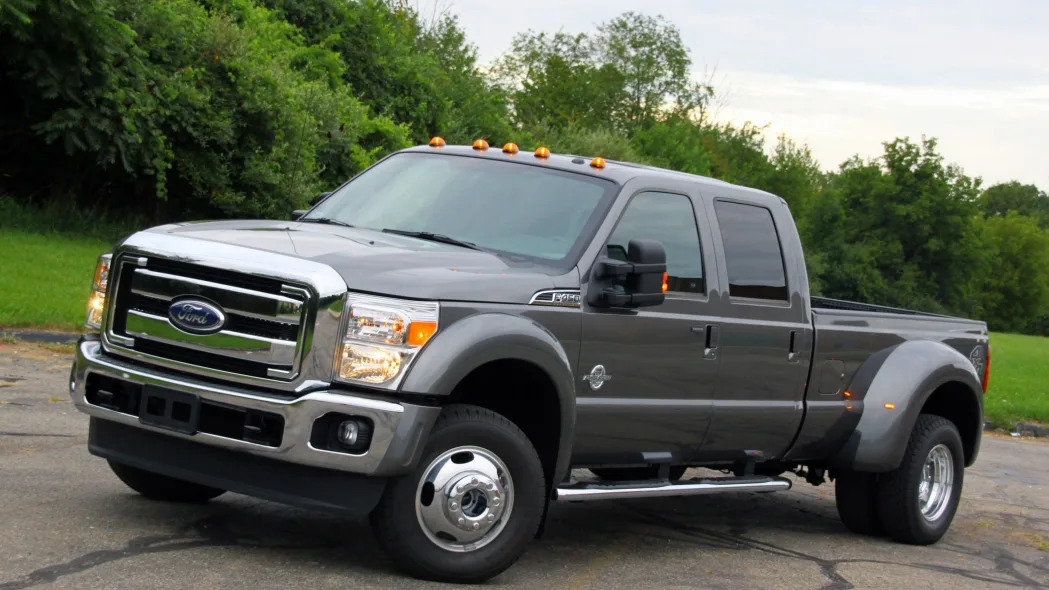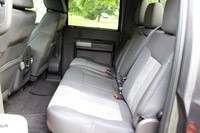Industry Giant Still Working Hard to Stay Ahead
2011 Ford F-450 Lariat – Click above for high-res image gallery
Ask any economics professor – competition is a good thing. Exhibit A? The large pickup truck market. Ford F-Series trucks have been the number-one selling vehicle line in the United States for more than three decades, but the automaker has never grown complacent. Each new iteration has been bigger, badder and more capable than its predecessor, and that goes twofold for Dearborn's heavy-duty models.
Despite the fact that Toyota and Nissan never followed up their light-duty trucks with three-quarter or one-ton models, just the threat of such entries spurred Ford, General Motors and Dodge to significantly up their games. In the first half of 2010, the Detroit Three have introduced revamped heavy-duty pickups to feed a segment that, while shrinking, remains large and highly profitable. With that in mind, we saddled up to the Big Daddy of the F-Series range, the F-450, to see if the behemoth could play the dual roles of load-lugger and daily ride. Click through the jump to see how we fared.
Photos copyright ©2010 Sam Abuelsamid / AOL
If you discount oddball brutes like the International CXT, the Ford F-450 defines the upper limit of pickup trucks in nearly every way. The F-450 is only available as a crew cab with an eight-foot bed, four-wheel drive, dual-rear-wheel axle and Ford's all-new 6.7-liter PowerStroke diesel V8. If you need to tow large items – a single-family home or a beer-brewer's team of Clydesdales – an F-450 fits the bill with ease.
Since the mid-1990s, Ford has slowly separated the styling of the Super Duty from the light-duty F-150, and the latest iteration takes that practice to a new extreme. One look at that massive grille and it's obvious this is no truck for poseurs. From its base XL trim with black painted grille to our chromed Lariat tester, the F-450 is beyond imposing, with its vertically stacked headlight clusters, cab-mounted auxiliary lights and extended wheel arches. Despite being nearly new, the latest Super Duty models continue to retain the cut-down side glass near the mirrors and Tonka truck blockiness we've seen on every iteration for the last decade.
The only element that detracts from this Blue Oval's manly styling is its rolling stock. Even with eight-lug hubs, the 17-inch wheel and tire package looks downright tiny. Yet despite the visually small size, this combination provides plenty of load carrying capacity with a maximum payload of 5,000 pounds and a 24,000+ pound towing capacity.



Grab the handle on the A-pillar, get a footing on the side-step, and as soon as you're inside, those familiar with the last-generation Super Duty will feel right at home. Aside from some minor trim updates in the center stack, the rest of the dashboard features the same angular and ribbed hard plastic look as before. While the interior is hardly upscale, the materials appear durable and well-suited to a work vehicle likely to be exposed to dust, dirt and the occasional blast of mud. And don't worry about keeping hydrated, as the Super Duty packs a plethora of cupholders on nearly every horizontal surface.
XL and XLT trim F-450s come with a 40/20/40 split front bench, while out Lariat tester replaces that central seat with an immense center console. The two-tone black and gray leather seats are as flat as the V8's torque curve, but with high cornering forces low on the priority list, serious bolstering isn't as much of a concern as easy repeated ingress and egress.
All F-450s come equipped ready for towing and up-fitting with auxiliary equipment like winches and power-take-offs. The switch to enable the tow-haul mode is integrated into the column-mounted shift lever and the automatic trailer brake control and auxiliary switches are located at the base of the center stack. The F-450 is equipped with Ford's Sync system, which makes managing iPods, phone calls and navigation destinations a breeze with voice commands.
We haven't had an opportunity to try the new Scorpion diesel V8 in cold weather, but in warm weather, it fires instantly and runs remarkably quietly, although it's not as refined at idle as the revised Duramax diesel in General Motors' HD trucks. At light-loads, the Scorpion still exhibits a hint of the clatter that's remained a characteristic of diesels past, but it largely disappears under load and is non-existent while cruising around town or on the freeway.

Using a vehicle that's nearly 22 feet long with over 14 feet between the axles takes extra care around town, especially when you factor in the eight-foot width with the duallie rear axle. When we got our first tutorial on driving a truck with a trailer, we were told to pull farther out into the intersection when turning and use the mirrors to make sure we didn't clip curbs. Even without a trailer hooked up, the same applies to the F-450.
The big power-operated wings hanging off the doors feature a standard mirror in the upper portion with a smaller convex mirror down below to keep tabs on the rear fenders. We found ourselves checking the mirrors more frequently to ensure we weren't straying from our lane, suggesting that these massive duallies might benefit from the new lane departure warning and preventions systems currently available on other luxury models.




Ford beat GM out of the gate early this year with the announcement of the specifications for the new Super Duty, and as a result, GM's numbers came in just ever so slightly higher across the board when its trucks were announced a few weeks later. In reality, the differences are inconsequential, but that didn't stop Ford from going back to its dyno lab and coming out with some revised calibrations that have been implemented as a running change. The new settings up the output of the diesel from the 390 horsepower and 735 pound-feet of our test truck to an even 400 hp and 800 lb-ft, giving bragging rights back to Dearborn. Ford will apply the software upgrade to all existing Super Duty trucks when they come in to the dealership for service.
While we didn't have an opportunity to test this F-450 with a trailer, we did load it up for a trip to the local township compost site. With several hundred pounds of old lumber and building materials in the back, we didn't even make a dent in the 5,000 pound payload capacity. Nonetheless, the utility of a pickup with an eight-foot bed is hard to deny. And with a truck this tall, the optional tailgate step should be standard equipment. Trust us – tick the box.

In the last couple of months, we have had other opportunities to drive similar diesel-powered F-350s with trailers of 10,000-12,000 pounds back-to-back with comparable GM trucks. While the Duramax-powered haulers accelerated slightly quicker than the Fords, the exercise was effortless for the Dearborn machines. No matter what we hitched up, this truck had plenty of get-up-and-go.
Even though the F-450 is not built for runs to the grocery store, we like to focus on the day-to-day, so we also tried it out in this capacity. Once you get used to placing the duallie in the lane in order to avoid... situations, the F-450 is remarkably easier and more pleasant to drive than similar vehicles of just a few years ago. There's no dynamic prowess to speak of, but unlike GM, which uses an independent front suspension, Ford has retained its traditional twin-I-beam for lesser rear-wheel-drive Super Duties and a coil-sprung live axle for 4x4s like the F-450.


The result is a ride that is improved and actually surprisingly comfortable on smooth roads, but not as quite as well-controlled as its GM competition when the pavement is less than ideal. Over roads with repeating frost breaks, the F-450 exhibited a light longitudinal heaving motion that we haven't experienced before. Granted, it wasn't enough to make us nauseous, but it was just enough to be noticeable. Equally noticeable was the steering, which was devoid of slop or on center dead-zones, although the general sensation was that of a system that is over-boosted and slow. Like, five turns lock-to-lock slow.
But for a truck designed to tow large trailers, slow steering is helpful in preventing the driver from inducing any sway while cruising down the road. If the trailer does begin moving around, the newly standard sway control will quickly bring things back in line by applying the brakes alternately to each side of the truck until everything settles out.

During our week with the F-450, we were able to average around 15 miles per gallon – rather impressive for an 8,000 pound truck with the frontal area of a pole barn. Equally impressive was its acceleration and braking. Even on a gravel back road, the F-450 can sprint to 60 mph in just over nine seconds, and on pavement, it's even quicker. As equipped with the navigation system and a sunroof, our tester stickered at $63,655 – pretty typical for a truck of this size and capability, but high enough to turn off most poseurs who would be better served by an F-150.
The people who buy these generally need them and often accumulate a lot more miles per year than the average driver. It's not unusual for these heavy-duty diesel trucks to accumulate half-a-million miles or more before being put out to pasture. The F-450 can easily handle just about any task you put to it – as long as its massive rear wheel arches will fit.
Photos copyright ©2010 Sam Abuelsamid / AOL







Sign in to post
Please sign in to leave a comment.
Continue